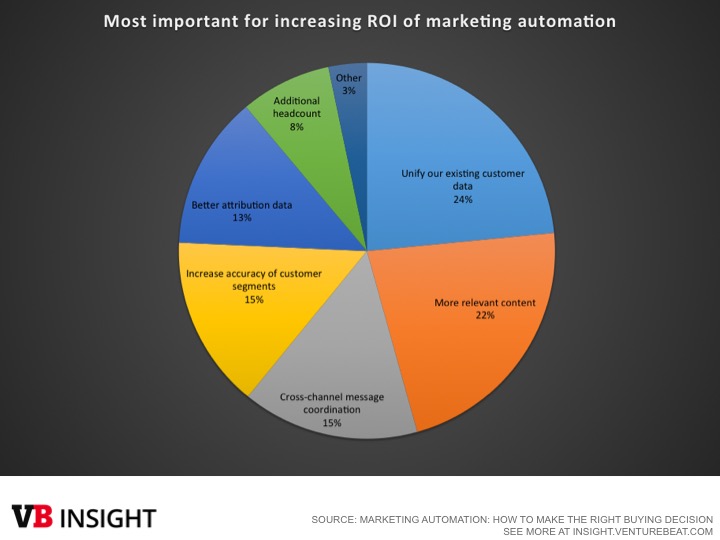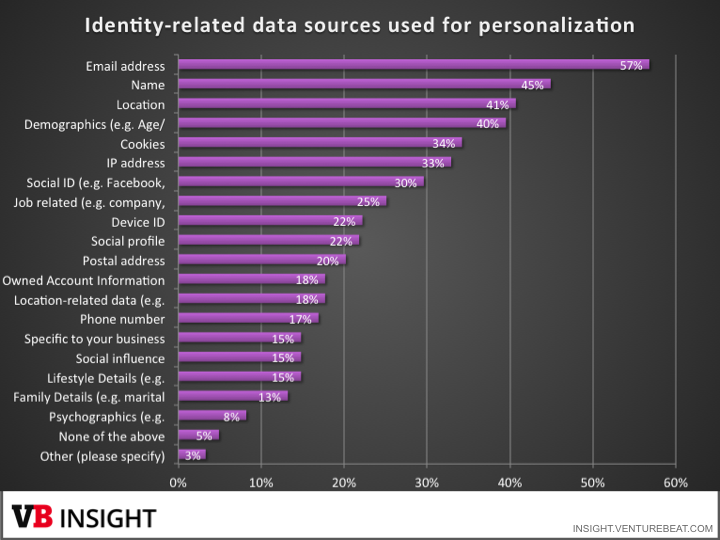The modern marketing technology stack is often a horrific snaggle-toothed mess of purchased, inherited, acquired, forgotten, misused, and someone-really-still-uses-that tools, often owned and managed by multiple people, and not completely documented anywhere.
This is a real problem when you want to personalize your marketing. And personalizing your marketing is a big step towards improving conversion, lift, and ROI.

Above: Data unification is marketers’ biggest challenge
It can drive 3.2X lift in email open rates, for instance, says Avari, 20-50 percent improvement in conversion rates, according to Sailthru, and a 20+ percent increase in customer lifetime value. Our own research at VB has found that personalization is a major priority for marketers in 2015 and can result in doubling conversion for marketers using marketing automation systems.
“Personalization sets you apart from competitors,” says Andrew Jones, a VB research analyst. “It means relevance to customers, whether they know and appreciate it or not — it works.”
Capturing, unifying, and using customer data to drive revenue growth
is available on VB Insight for $99, or free with your martech subscription
But it’s hard to do in a very diverse technological stack … which is one major reason why many marketers who are trying to do personalized marketing are failing, or being limited to ye olde mail merge insert-names-into-emails.
“Far fewer are doing much beyond that,” he says.
Jones’ new report on identity, marketing, and using customer data to drive revenue growth reports five main ways of centralizing customer data, each of which is appropriate for different companies in varying spaces.
They are:
- Tag Management Systems (TMS)
- Customer Data Hubs
- Customer Identity Management
- Customer Profile Management
- Data Management Platforms (DMPs)
Tag management, such as that provided by Tealium and Ensighten, helps brands capture and unify all the data that every tool in their web and mobile tech stack is capturing. That includes data from analytics packages, ads, CRM systems, A/B and multivariate testing tools, and more. Once all that data is aggregated in a single place, marketers have a much more complete picture of their customers and prospects.
Jones says a similar but distinct category is customer data hubs, which ingest all the data from various hubs, and spit it back to you as needed. The only example in the category? Segment.
 A more common category is customer identity management, which we used to call single sign-on or social sign-on. Vendors like Gigya, Jainrain, and LoginRadius provide solutions here, but these only focus on known customers — not anonymous visitors.
A more common category is customer identity management, which we used to call single sign-on or social sign-on. Vendors like Gigya, Jainrain, and LoginRadius provide solutions here, but these only focus on known customers — not anonymous visitors.
Consumer profile management might be the most sophisticated category, and here’s where you’ll find the marketing clouds, such as those offered by Adobe, Salesforce, Oracle, and Marketo. These are typically aggregated conglomerations of technologies for all different kinds of marketing needs on web, social, and mobile, but some, like Sailthru, AgilOne, and HubSpot, are integrated, purpose-built, and unified software tools. The customer experience platforms like SDL and Sitecore fit here as well.
Finally, some marketers rely on data management platforms to unify their customer records as well as bolster them with third-party data, such as offline purchase data. Companies here would include BlueKai, Aggregate Knowledge, and many others, including tools embedded within marketing clouds.
Which tool you use will depend on what kind of company you are, and what your needs require, Jones says. But it’s not optional:
“Data unification is critical to get a better view of your customer,” he says. “If data in one channel suggests you’re talking to a teenage boy, but he’s using his mom’s laptop, data from another channel may tell you who it really is and even what else they care about. With each piece of data we get a better idea of identity.”
The entire report is available on VB Insight for $99, or free with your VB martech subscription.
VentureBeat's mission is to be a digital town square for technical decision-makers to gain knowledge about transformative enterprise technology and transact. Learn More


